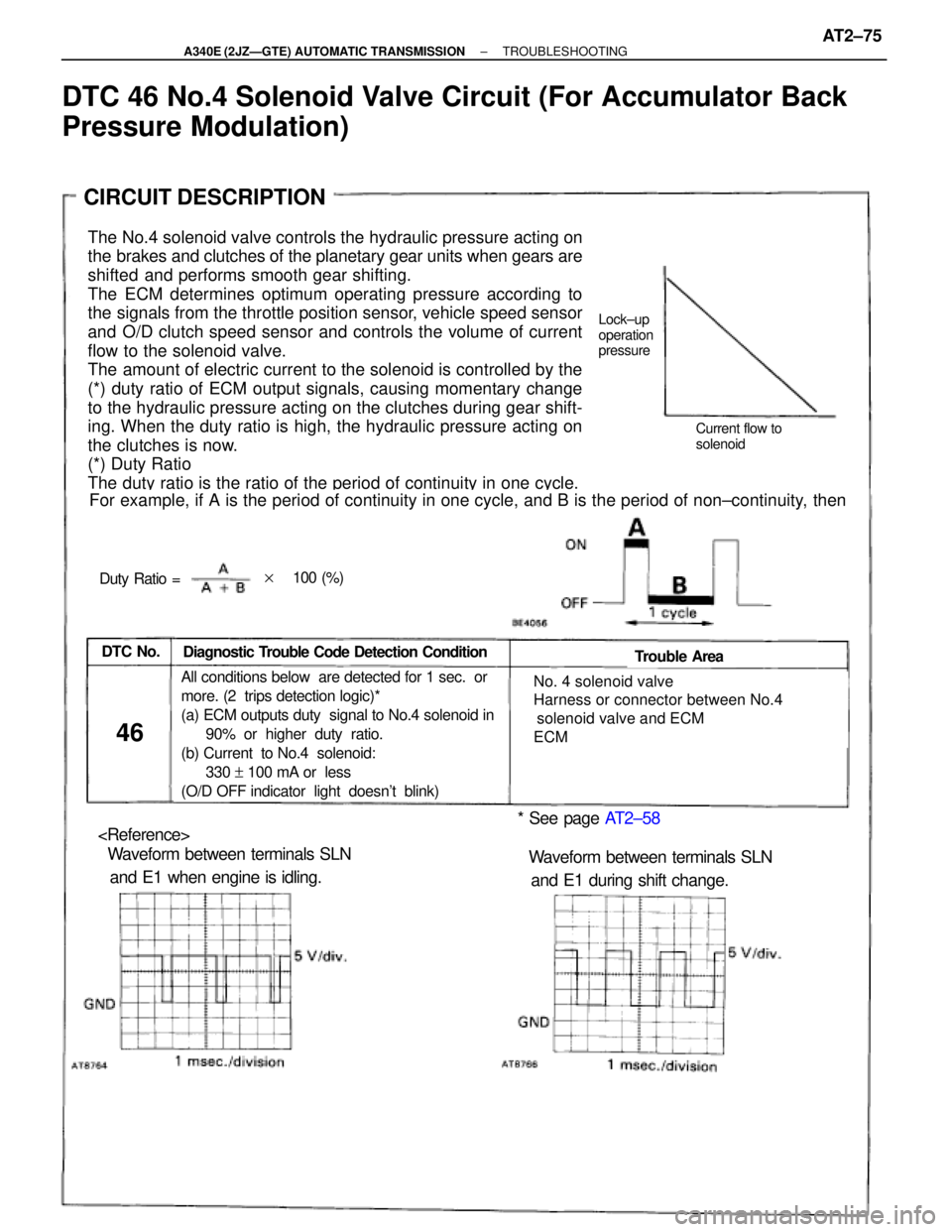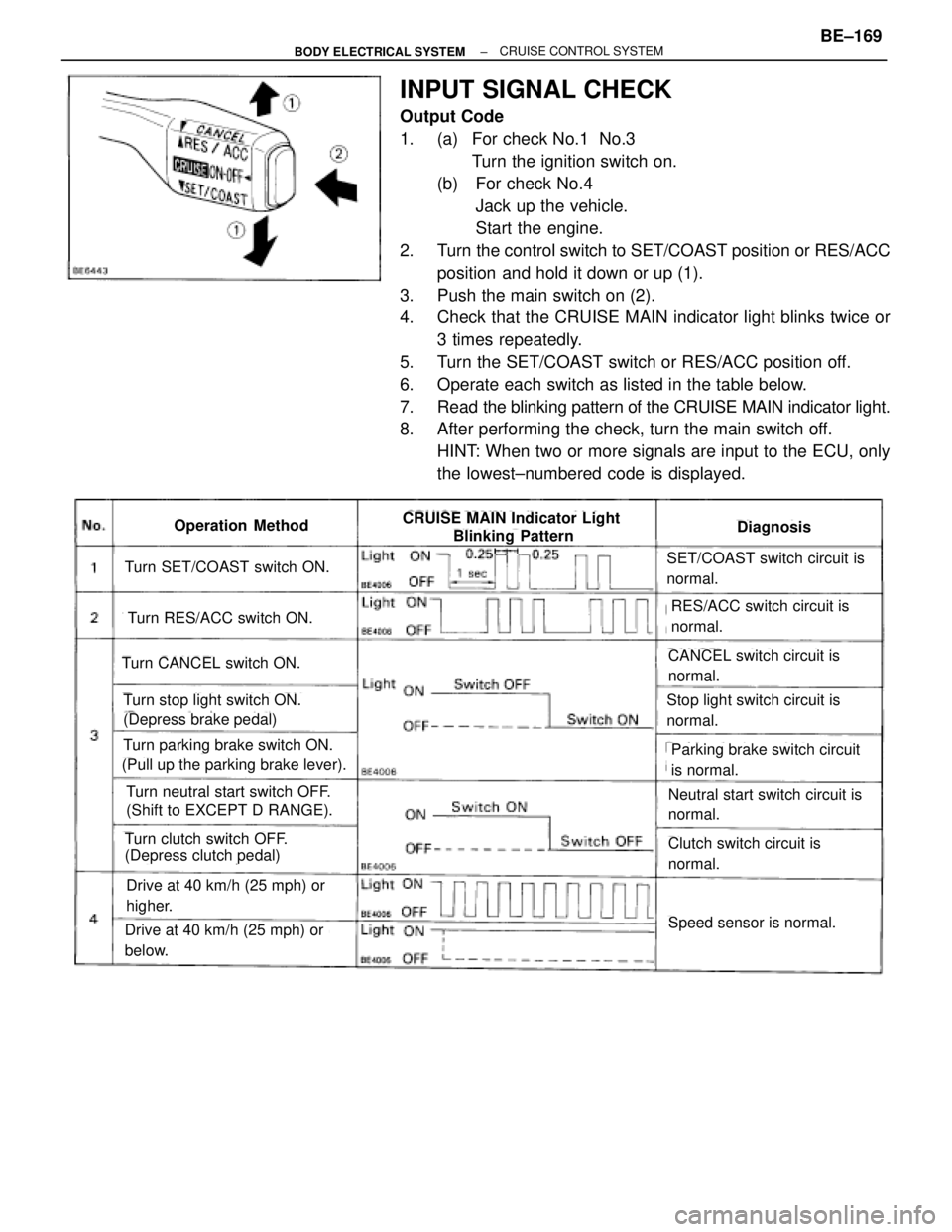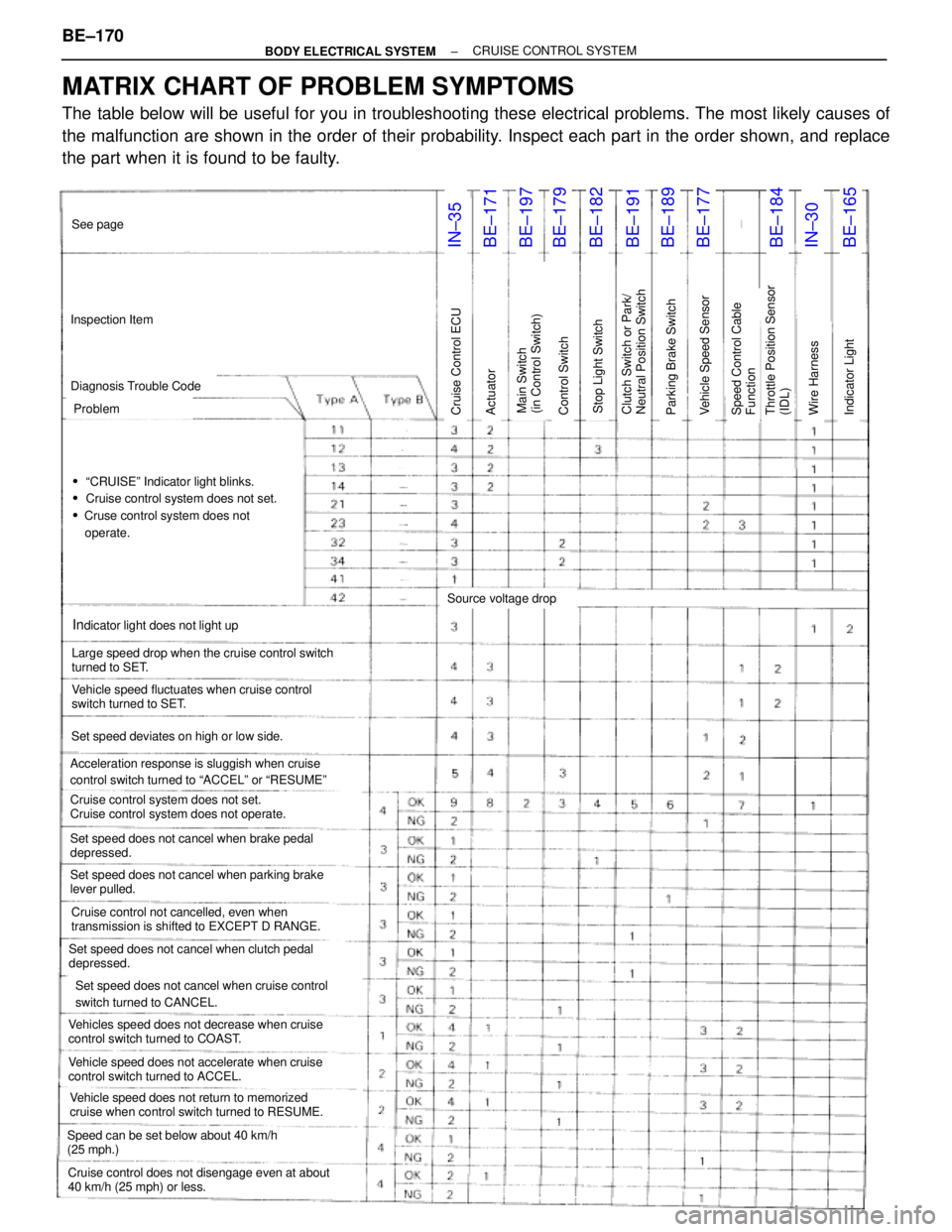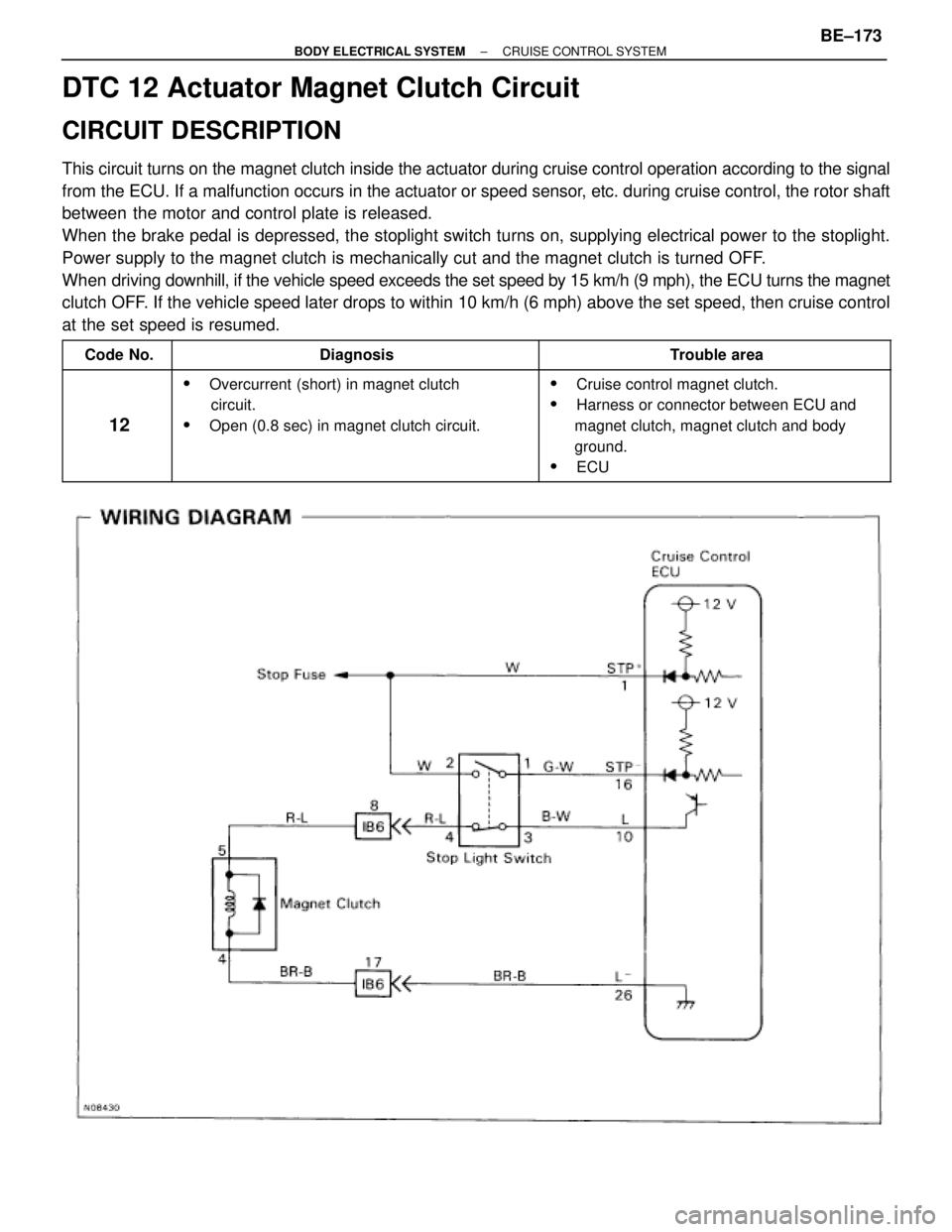Page 559 of 2543

The No.4 solenoid valve controls the hydraulic pressure acting on
the brakes and clutches of the planetary gear units when gears are
shifted and performs smooth gear shifting.
The ECM determines optimum operating pressure according to
the signals from the throttle position sensor, vehicle speed sensor
and O/D clutch speed sensor and controls the volume of current
flow to the solenoid valve.
The amount of electric current to the solenoid is controlled by the
(*) duty ratio of ECM output signals, causing momentary change
to the hydraulic pressure acting on the clutches during gear shift-
ing. When the duty ratio is high, the hydraulic pressure acting on
the clutches is now.
(*) Duty Ratio
The duty ratio is the ratio of the period of continuity in one cycle.
For example, if A is the period of continuity in one cycle, and B is the period of non±continuity, then
Diagnostic Trouble Code Detection ConditionDTC No.Trouble Area
46
� No. 4 solenoid valve
� Harness or connector between No.4
solenoid valve and ECM
� ECMAll conditions below are detected for 1 sec. or
more. (2 trips detection logic)*
(a) ECM outputs duty signal to No.4 solenoid in
90% or higher duty ratio.
(b) Current to No.4 solenoid:
330 + 100 mA or less
(O/D OFF indicator light doesn't blink)
* See page AT2±58
� Waveform between terminals SLN
and E1 when engine is idling.� Waveform between terminals SLN
and E1 during shift change.
Lock±up
operation
pressure
Current flow to
solenoid
Duty Ratio =
CIRCUIT DESCRIPTION
��100 (%)
DTC 46 No.4 Solenoid Valve Circuit (For Accumulator Back
Pressure Modulation)
± A340E (2JZÐGTE) AUTOMATIC TRANSMISSIONTROUBLESHOOTINGAT2±75
Page 582 of 2543
INSPECTION PROCEDURE
Check main throttle position signal.
Voltage changes from 0 V to 8 V by stages.
Turn ignition switch ON.
Do not depress the brake pedal during the test. The
voltage will stay at 0 V if depressed.
Check voltage at the terminal TT of the DLC2 while
gradually depressing the accelerator pedal from
the fully closed position to the fully opened position.
(Close) Throttle Valve Opening Angle (Open)
Proceed to next circuit inspection shown on
matrix chart (See page AT2±64).
Replace throttle position sensor.
Repair or replace harness or connector.
Check main (sub)±throttle position sensor. (see page EG±292, 293)
Check harness and connector between ECM and Main (Sub)±throttle
position sensor (See page IN±30).
Check and replace ECM.
AT2±98± A340E (2JZÐGTE) AUTOMATIC TRANSMISSIONTROUBLESHOOTING
Page 599 of 2543
TT Terminal Circuit
CIRCUIT DESCRIPTION
Checks of ECM input and output signals related to the throttle position sensor, brakes, shift position and
other circuits can be performed by measuring the voltages at terminal TT of the DLC2
INSPECTION PROCEDURE
Repair or replace harness or connector.
Check and replace ECM.
Check harness and connector between ECM and DLC2, DLC1 and body
ground (See page IN±30).
± A340E (2JZÐGTE) AUTOMATIC TRANSMISSIONTROUBLESHOOTINGAT2±115
Page 771 of 2543

INPUT SIGNAL CHECK
Output Code
1. (a) For check No.1 No.3
Turn the ignition switch on.
(b) For check No.4
Jack up the vehicle.
Start the engine.
2. Turn the control switch to SET/COAST position or RES/ACC
position and hold it down or up (1).
3. Push the main switch on (2).
4. Check that the CRUISE MAIN indicator light blinks twice or
3 times repeatedly.
5. Turn the SET/COAST switch or RES/ACC position off.
6. Operate each switch as listed in the table below.
7. Read the blinking pattern of the CRUISE MAIN indicator light.
8. After performing the check, turn the main switch off.
HINT: When two or more signals are input to the ECU, only
the lowest±numbered code is displayed.
Turn SET/COAST switch ON.
Turn RES/ACC switch ON.
Turn CANCEL switch ON.
Turn stop light switch ON.
(Depress brake pedal)
Turn parking brake switch ON.
(Pull up the parking brake lever).
Turn neutral start switch OFF.
(Shift to EXCEPT D RANGE).
Turn clutch switch OFF.
(Depress clutch pedal)
Drive at 40 km/h (25 mph) or
higher.
Drive at 40 km/h (25 mph) or
below.
SET/COAST switch circuit is
normal.
RES/ACC switch circuit is
normal.
CANCEL switch circuit is
normal.
Stop light switch circuit is
normal.
Parking brake switch circuit
is normal.
Neutral start switch circuit is
normal.
Clutch switch circuit is
normal.
Speed sensor is normal.
DiagnosisOperation MethodCRUISE MAIN Indicator Light
Blinking Pattern
± BODY ELECTRICAL SYSTEMBE±169CRUISE CONTROL SYSTEM
Page 772 of 2543

IN±35BE±171BE±197BE±179BE±182BE±191BE±189BE±177BE±184BE±165IN±30
See page
Inspection Item
Problem
�ªCRUISEº Indicator light blinks.
�Cruise control system does not set.
�Cruse control system does not
operate.
Diagnosis Trouble Code
Indicator light does not light up
Large speed drop when the cruise control switch
turned to SET.
Vehicle speed fluctuates when cruise control
switch turned to SET.
Set speed deviates on high or low side.
Acceleration response is sluggish when cruise
control switch turned to ªACCELº or ªRESUMEº
Cruise control system does not set.
Cruise control system does not operate.
Set speed does not cancel when brake pedal
depressed.
Set speed does not cancel when parking brake
lever pulled.
Cruise control not cancelled, even when
transmission is shifted to EXCEPT D RANGE.
Set speed does not cancel when clutch pedal
depressed.
Set speed does not cancel when cruise control
switch turned to CANCEL.
Vehicles speed does not decrease when cruise
control switch turned to COAST.
Vehicle speed does not accelerate when cruise
control switch turned to ACCEL.
Vehicle speed does not return to memorized
cruise when control switch turned to RESUME.
Speed can be set below about 40 km/h
(25 mph.)
Cruise control does not disengage even at about
40 km/h (25 mph) or less.
Indicator LightCruise Control ECUActuatorMain Switch
(in Control Switch)Control SwitchStop Light SwitchClutch Switch or Park/
Neutral Position SwitchParking Brake SwitchVehicle Speed SensorSpeed Control Cable
FunctionThrottle Position Sensor
(IDL)Wire Harness
Source voltage drop
MATRIX CHART OF PROBLEM SYMPTOMS
The table below will be useful for you in troubleshooting these electrical problems. The most likely causes of
the malfunction are shown in the order of their probability. Inspect each part in the order shown, and replace
the part when it is found to be faulty. BE±170
± BODY ELECTRICAL SYSTEMCRUISE CONTROL SYSTEM
Page 775 of 2543

DTC 12 Actuator Magnet Clutch Circuit
CIRCUIT DESCRIPTION
This circuit turns on the magnet clutch inside the actuator during cruise control operation according to the signal
from the ECU. If a malfunction occurs in the actuator or speed sensor, etc. during cruise control, the rotor shaft
between the motor and control plate is released.
When the brake pedal is depressed, the stoplight switch turns on, supplying electrical power to the stoplight.
Power supply to the magnet clutch is mechanically cut and the magnet clutch is turned OFF.
When driving downhill, if the vehicle speed exceeds the set speed by 15 km/h (9 mph), the ECU turns the magnet
clutch OFF. If the vehicle speed later drops to within 10 km/h (6 mph) above the set speed, then cruise control
at the set speed is resumed.
������ ������Code No.���������������� ����������������Diagnosis���������������� ����������������Trouble area
������ �
����� �
����� �
����� �
����� ������
12
���������������� �
��������������� �
��������������� �
��������������� �
��������������� ����������������
��Overcurrent (short) in magnet clutch
circuit.
��Open (0.8 sec) in magnet clutch circuit.
���������������� �
��������������� �
��������������� �
��������������� �
��������������� ����������������
��Cruise control magnet clutch.
��Harness or connector between ECU and
magnet clutch, magnet clutch and body
ground.
��ECU
± BODY ELECTRICAL SYSTEMCRUISE CONTROL SYSTEMBE±173
Page 917 of 2543
FRONT SPEED SENSOR
COMPONENTS
FRONT SPEED SENSOR REMOVAL
Installation is in the reverse order of removal.
AFTER INSTALLATION, CHECK SPEED SENSOR SIG-
NAL (See page BR±62)
1. DISCONNECT CONNECTOR
(a) Remove the front fender splash shield.
(b) Disconnect the speed sensor connector.
2. REMOVE SPEED SENSOR
(a) Remove the 3 clamp bolts holding the sensor harness to the
body and upper suspension arm.
Torque: 5.4 NVm (55 kgfVcm, 48 in.Vlbf)
(b) Remove the speed sensor from the steering knuckle.
Torque: 7.8 NVm (80 kgfVcm, 69 in.Vlbf)
(c) Remove the O±ring from the speed sensor. BR±48
± BRAKE SYSTEMANTI±LOCK BRAKE SYSTEM (ABS)
Page 918 of 2543
REAR SPEED SENSOR
COMPONENTS
REAR SPEED SENSOR REMOVAL
Installation is in the reverse order of removal.
AFTER INSTALLATION, CHECK SPEED SENSOR SIG-
NAL (See page BR±62)
1. DISCONNECT SPEED SENSOR CONNECTOR
(a) Remove the rear seat cushion and seat back.
(b) Remove the quarter trim panel.
(c) Disconnect the speed sensor connector, and pull out the
sensor wire harness with the grommet.
2. REMOVE SPEED SENSOR
(a) Remove the 2 clamp bolts holding the sensor wire harness
to the body and upper arm.
Torque: 5.4 NVm (55 kgfVcm, 48 in.Vlbf)
(b) Remove the speed sensor from the axle carrier.
Torque: 7.8 NVm (80 kgfVcm, 69 in.Vlbf)
± BRAKE SYSTEMANTI±LOCK BRAKE SYSTEM (ABS)BR±49